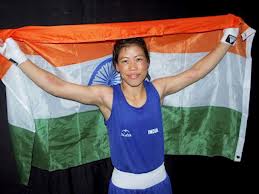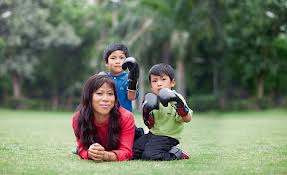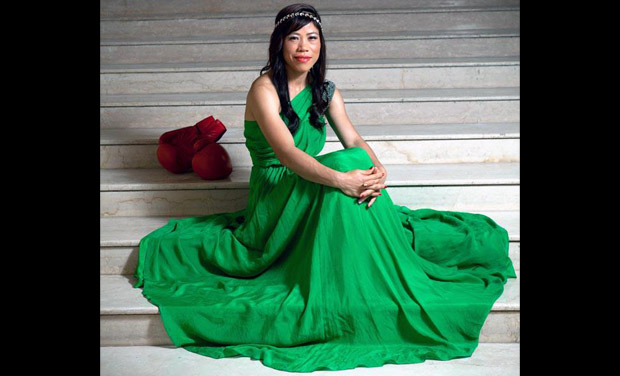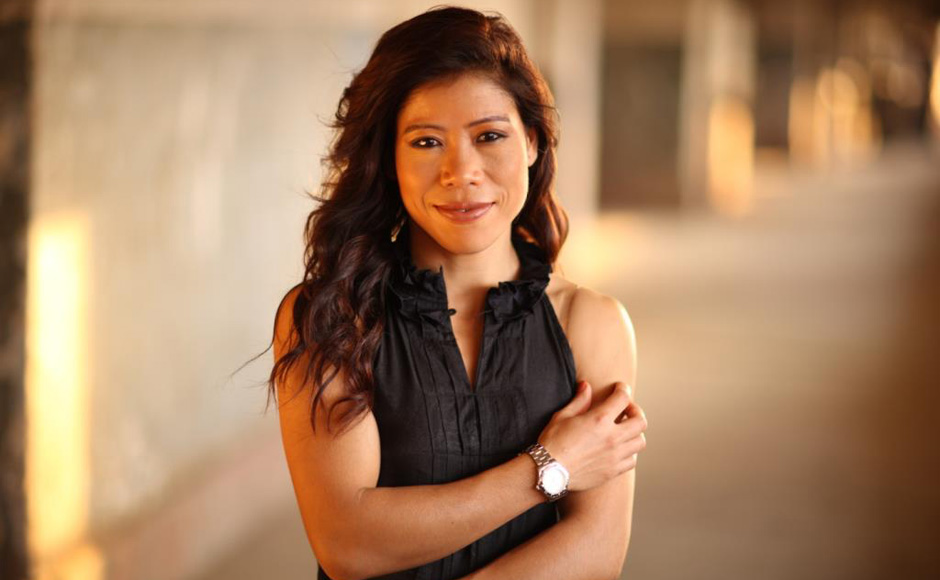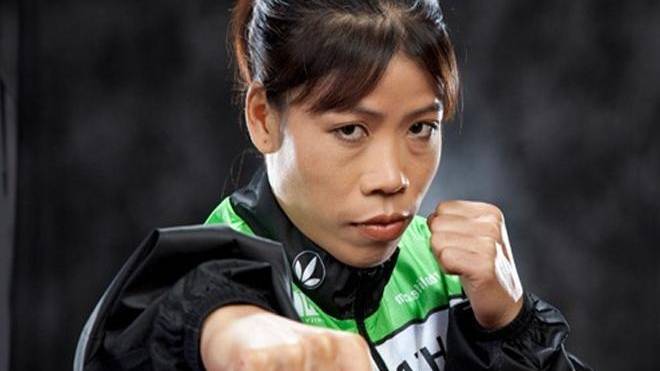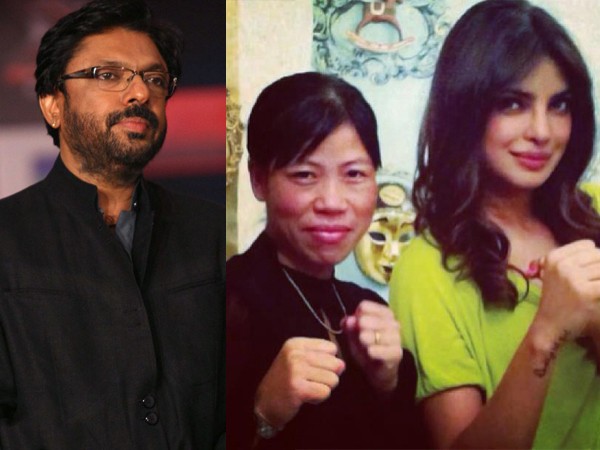Mary Kom
See also Mary Kom, the film
This is a collection of articles archived for the excellence of their
content. You can update or correct this page, and/ or send photographs to the Facebook page, Indpaedia.com. All information used will be duly acknowledged. |
The authors of this article
A Mayang has curated and compiled this article through patchwork. The actual authors are:
BBC Moska Najib
The New York Times 2012/08/07
Time 2012/08/04
The Times of India 2013-05-18
Introduction and summary
Mangte Chungneijang Mary Kom is arguably India’s most successful boxer ever, male or female, and a national heroine and role model.
Mary Kom is famed as a five consecutive time World Boxing Champion and the only boxer to win a medal in every one of the six world championships. In the 2012 Olympics, she became the first Indian women boxer to qualify and win a bronze medal in the 51 kg flyweight category of Boxing. She was subsequently ranked as Number. 4 in the Flyweight category of AIBA World Women's Ranking.
Mary Kom has been fighting in the 46-kilogram and 48-kilogram weight slots for most of her boxing career, but she trained hard to gain weight to qualify for the 51-kilogram category, the lowest of the three weight classes established for female boxers at the London Olympics. Kom has fought as a pinweight, in the 46-kg class, or as a light flyweight, the 48-kg category. Of the five world championships that she won, three were before her twin boys were born, and two after.
Her interest in boxing was inspired by the success of her compatriot Manipuri male boxer Dingko Singh.
Early life
Also known as Chungneijang Hmangte, Merykom and MC Merykom, she was born on 1st March 1983, in the isolated Kangathei Village (population: 300), ringed by razor wire and darkened by constant power cuts in the Moirang Lamkhai area of Manipur. Her grandmother named her Chungneijang, which means “prosperous” in the Kom tribe’s dialect. The lady brought prosperity to her family, honour to the Kom tribe and Manipur and pride to her grateful nation.
As a child, Kom rarely ate meat or fish — it was too expensive. Her parents were landless farmers.
Mary Kom is a Christian. Height 5’2”
She told Reader’s Digest ‘I decided to assume [the name Mary] when I set out to build a career in sports. I wanted a name that was easier to pronounce and I chose Mary because it shows my faith as a Christian.
Education
She did her schooling from Loktak Christian Model High School, Moirang till class VI and studied in St. Xavier Catholic School, Moirang till class VIII. She then completed her schooling from NIOS, Imphal and did her graduation from Churachandpur College.
Between attending school, caring for her younger siblings and playing all kinds of sports including hockey, football and athletics (but not boxing), Mary Kom worked in the fields and helped her parents, both farm hands.
Family
“My parents had to feed and educate four children. I’m the eldest.”—MC Mary Kom.
Mary Kom is a mother of twin sons, Rechungvar and Khupneivar; and is married to K Onler Kom.
Mary Kom was blessed with a third son, Prince Chungthanglen Kom, in Imphal, in 2013. She was actually praying for a girl. She said: "My husband Onler says we can still try for a girl next time, God willing!"
Her father-in-law was killed under mysterious circumstances, possibly by insurgents.
Inspired by Dingko Singh
She took to sports in an effort to provide some financial support to her family. "I was initially an all-round athlete, and 400-m and javelin were my pet events.” For this she shifted to the state capital, Imphal.
Reader’s Digest adds, ‘Dressed in torn, shabby clothes, the teenager approached coach K. Kosana Meitei at the Sports Authority of India there and asked to be given a chance. The coach remembers her practising punches late into the night, long after the others had gone to bed.’
She had an eager interest in athletics since childhood and the success of Dingko Singh is what really inspired her to become a boxer.
When Dingko Singh returned from Bangkok (Asian Games) with a gold, I thought I should give it a try. Dingko's success triggered a revolution of sort in Manipur and surprisingly I found that I was not the only girl who was drawn into boxing," she said.
Watching Jackie Chan's stunts on the big screen was a favourite past-time.
She convinced a local coach, K. Kosana Meitei, to train her as a boxer too. Mary started her boxing career in 2000 and was a quick learner who preferred to be put through the same paces as the boys around her. "In just two weeks, I had learnt all the basics. I guess I had God-given talent for boxing."
“After my first match at the state level sub-junior boxing championship in 2000, I was adjudged best boxer. That’s when I learnt that God has gifted me with this talent.”—MC Mary Kom.
And within a year of strapping on gloves, she was a national champion, Time magazine pointed out.
Somini Sengupta added in The New York Times: At 17, she left home to join a government-run sports training center in Imphal, the capital of her home state, Manipur, and begged the boxing coach to let her enter the ring.
“She was so small, I told her no,” the coach, L. Ibomcha Singh, said. Tears rolled down her face. The coach relented.
Breaking societal barriers
She initially tried to keep her interest in the sweet science from her father, M. Tonpu Kom, and mother Saneikham Kom, but winning a 2000 State championship got her photograph in the newspaper - and her secret was out of the bag:
Her father goaded her to give it up. Boxing is too dangerous, he told her. Members of her clan disapproved. The boys in her hometown ridiculed her. She held out.
“One day, I will show you who I am,” she recalled thinking.
"I still remember I was castigated by my father who said with a battered and bruised face, I should not expect to get married. He was furious that I took to boxing - a taboo for women - and he did not have the slightest idea about it. But my passion for the sport had got the better of me and I thank my cousins who coaxed and cajoled my father into eventually giving his nod. I'm happy that I did not let anybody down," she told the Deccan Herald in September 2004.
Early career
After winning her first title and Best Boxer at the First State Level Invitation women's boxing championship in Manipur in 2000, Merykom went on to win the gold in the Seventh East India Women’s Boxing Championship held in West Bengal and subsequently to win five Indian National Championships from 2000 to 2005.
She also embarked on an international campaign that has brought her a series of gold medals and honors, though not without a few setbacks.
Struggle and setbacks
“The tales of my struggles have no end. I did not have enough money to afford my basic needs like sports kits and a proper diet,” she told India Ink in a recent interview. The stumbling blocks she faced, including a lack of basic training and adequate facilities, encouraged her to create in 2006 a boxing academy in her home state for aspirants like her.
On her way by train to the selection camp for her first Asian Women’s Boxing Championships in Bangkok, Thailand, she had all her luggage and her passport stolen. Her parents asked her to come home but she carried on her course. "My saviour was a city-based uncle, who said he’d fix everything if I got selected. I did, but I returned empty handed (from the meet in Bangkok). The stress following the loss of documents and luggage interfered with my training." Her solution was still more training. "We girls really worked hard. Women’s boxing was a very recent introduction, and we really wanted to excel."
2001, 2002
In 2001, she lost in the final and had to settle for a silver medal. In 2002, she started her domination at the AIBA World Championships where she won her first gold.
International triumphs
Hissar, India
Merykom's "international gold rush" finally began with the Second Asian Women's Championship in Hissar and continued with a win in the Third Asian Women's Championship held in Taiwan.
2001: Scranton, USA
She was only 18 years old when she made her international debut at the first AIBA World Women's Boxing Championship in Scranton, USA in 2001. Merykom had to settle for silver, losing to Hulya Sahin of Turkey by 13-5 in the 48-kg final after defeating Jamie Behl of Canada by 21-9 in the semi-final and Nadia Hockmi of Poland by RSCO-3 in the quarter-final. "She was leading in the first round but her opponent managed to score points in the final round," coach Anoop Kumar said of Merykom's performance in the final.
2002: Antalya, Turkey
The next year, she struck gold at the Second AIBA World Women’s Senior Boxing Championship held from October 21-27, 2002 in Antalya, Turkey, winning the 45-kg division by defeating Svetlana Miroshnichenko of the Ukraine in her semi-final and Jang Song-Ae of North Korea in the final
2003
November 22, 2003 in the 46-kg finals of the Asian Women's Championships at Mahabir Stadium in Hisar, India, she defeated Chou Szu Yin of Chinese Taipei by RSCO-2. She had previously defeated L. G. Chandrika of Sri Lanka also by RSCO-2.
She also won a gold medal in the 45 kg weight category at the Witch Cup in Hungary in the same year.
Father finally understands
Her once-skeptical father accompanied his trail-blazing daughter to the ceremony in 2003 at which she was the first woman ever to receive India's prestigious Arjuna award for her achievement in boxing.
"When he saw my photograph on the national newspaper, he was happy," she grins, admitting that for many years her father was unaware of her love for the sport.
2004
She also took gold in the 46-kg division of the Women's World Boxing Tournament in Tønsberg, Norway from 27 April to 2 May 2004, defeating Derya Aktop of Turkey by RSCO-2 in the semi-final and Xia Li of China by RSCO-2 in the final.
In 2004 she won a gold medal at the Women's Boxing World Cup in Norway.
She was also the Witch Cup Tournament champion in Hungary in 2004.
At the August 2004 Asian Women's Boxing Championships in Taiwan she defeated Gretchen Abaniel of the Philippines 35-11 in the 46-kg final.
2005
She successfully defended her 46-kg world title at the Third AIBA Women's World Championships held from 25 September to 2 October 2005 in Podolsk, Russia. She won the final by a 28-13 score over Jong Ok of North Korea, who had reached the finals with a 22-20 decision over Gretchen Abaniel of the Philippines. Kom had defeated Elena Sabitova of Russia 31-16 in her semi-final and Nancy Fortin of Canada 30-13 in her preliminary. While she saw her repeat win as great progress, she expressed admiration for the Russians, who won the team event. "They are so well-built, with big muscles!"
In 2005, she again won a gold medal at the Asian Women's Boxing Championship in Taiwan and the AIBA Women's World Boxing Championship in Russia both in the 46 kg weight class.
2006
On 19-22 October 2006 at the Venus Women's Box Cup in Vejle, Denmark, Merykom won by RSCO-2 over Sofie Molholr of Denmark in the 46-kg semi-final and defeated Steluta Duta of Romania by retirement in the third round. Duta had defeated Valeria Calabrese of Italy RSCI-2 to reach the final and had also won the 46-kg division of the Ahmet Comert Tournament in 2006 with a RSCO-2 over Derya Aktop of Turkey (Merykom did not compete in that tournament.)
On 23 November 2006 at the AIBA World Championships at Talkatora Indoor Stadium in New Delhi, India Merykom again won the 46-kg division - this time with a 22-7 decision over her Venus Box Cup final opponent Steluta Duta of Romania. Merykom kept the Romanian on the defensive for most of the bout, then celebrated her win with a demonstration of Manipuri folk dance in the ring. Duta reached the final with a RSCO-2 win over Boranbayeva Zalgul of Kazakhstan in the semi. In New Delhi, Merykom had previously defeated Jong Ok of North Korea 20-8 in the semi-final, and Chandrike Geruga of Sri Lanka by RSCO-2 in the quarter-final after a bye in the preliminary round. She began the tournament with a cough and fever (and was unable to take any medication because of the doping test) but she still performed well enough to lead Chandrike Geruga 13-3 after one round, and the bout was stopped in the second with Merykom ahead 19-4.
On this occasion the Indian women's boxing team edged the formidable Russians by 34 points to 28 in team standings.
2007
Mary Kom took a one year break.
Her greatest test, however, was getting back into the ring after the birth of her twin boys in August 2007. “It was hard to wean the boys off her breasts, harder still to leave them at home and go off to camp for a month at a time,” Ms. Sengupta wrote in The New York Times in 2009.
She amazed everyone with her dedication when it took her only a month to prepare for the Asian Championship, having being away for two years from the boxing ring because of the Caesarean birth of her twins. She won the silver medal.
2008
Mary Kom returned with a bang in 2008 to win a silver medal at the Asian Women's Boxing Championship held in India.
She then won a fourth successive gold medal at the AIBA Women's World Boxing Championship in China, both were in the 46 weigh category. Her feat earned her the title of 'Magnificent Mary' from the AIBA.
2009
In 2009 she won a gold medal at the Asian Indoor Games in Vietnam.
Mary Kom also became the International Boxing Association's Ambassador for Women's Boxing in 2009.
Ms. Kom’s chance for Olympic gold began in August 2009, when the International Olympic Committee announced that women’s boxing would be added at the 2012 London Olympics.
“This is my dream come true,” Ms. Kom had told Somini Sengupta of The New York Times days after the announcement.
2010
In 2010, Mary Kom won a gold medal at the Asian Women's Boxing Championship in Kazakhstan and her fifth consecutive gold medal in the AIBA Women's World Boxing Championship in Barbados. She now competed in the 48 kg weight class because AIBA had discontinued using the 46 kg class. She also participated in the 51 kg weight class at the Asian Games and won a bronze medal.
In the 2010 Commonwealth Games held in Delhi, India. She had the honor of holding the Queen's Baton along with Vijender Singh for the opening ceremony run in the stadium. However, she did not compete as women's boxing event was not included in the Games.
In 2010, she was voted India's Sportswoman of the Year.
2011
In 2011, she won a gold medal in the 48 kg weight class at the Asian Women's Cup in China.
2012/1
In 2012, she won a gold medal in the 51 kg weight class at the Asian Women's Boxing Championship in Mongolia.
Five-time world champion MC Mary Kom and L Sarita Devi on Sunday clinched gold medals in the 6th Asian Boxing Championships in Ulaanbaatar, Mongolia, helping India finish a creditable second in the overall standings.
While Mary Kom defeated current world champion and Asian Games gold medallist Ren Cancan of China 14/8 in the (51kg category), Sarita Devi (60kg) defeated Chorieva Mavzuna of Tajkistan 16-9.
With two gold medals, four silver and two bronze, India finished runners-up behind China
2012/ The London Olympics
On Aug. 5, 2012, her twin sons’ fifth birthday, Mary Kom began her quest for an Olympic podium finish.
In 2012, ‘’Time’’ commented, “Her event, the 51-kg flyweight class, is in itself a milestone: women’s boxing is debuting at the London Games, and Kom’s weight class, the lightest, will be the first up in women’s-boxing history.
“Kom will be fighting in an unfamiliar weight class in London. Women’s boxing may have gained an Olympic berth, but the sport has just three weight classes compared with 10 for the men. At the Olympics, the lightest division is flyweight, or 51 kg. So she bulked up by two weight classes to qualify for the Games. On Aug. 5, she will face Poland’s Karolina Michalczuk, who herself scaled down from the 54-kg bantamweight division to flyweight. Kom is now ranked fourth in the 51-kg weight class, while Michalczuk is fifth. If she prevails against the Polish fighter, the Indian pugilist is guaranteed a place in the quarterfinals. (The gold-medal favorite is Ren Cancan of China, with Great Britain’s Nicola Adams another strong contender.)”
Mary, who began the 45-kilo class, and competed in the 48-kilo class in 2010, was, in 2012, at the Olympics in the 51 kilo category. She had to put on five kilos to get up to 51kg.
In 2012 Mary Kom got a chance to win a rare Olympic gold medal for India when she faced Nicola Adams of Britain. India's Mary Kom went down to Nicola Adams 6 - 11 in the semi-final bout to settle for bronze in the women's fly category at the London Olympics M C Mary Kom on Monday created history as she assured India its fourth Olympic medal after winning her quarterfinal boxing bout against Maroua Rahali of Tunisia by 15-6 margin in the women's 51 kg category.
Ms. Kom, a five-time world champion, thus guaranteed herself a bronze medal when she won the quarterfinal of the women’s flyweight boxing event in London. (The losers of the semifinals are each awarded a bronze.)
“Her fight against Haringey's Nicola Adams was strangely beautiful to watch – the flyweight category is markedly different to the one above, chiefly in the sense that there's much less punching. In the earlier rounds, there were definitely pairs who spent the whole eight minutes doing their tired-hug and barely fought at all… Adams was larger, with longer arms, and as the contest progressed, she gained confidence in her advantage. By the fourth round, she looked almost at ease, possibly because Kom had swiped her one across the back of the head (this is not allowed) and was showing the strain.
“After Mary K won her opening fight on Sunday, she was crying in the mixed zone afterwards because it was her twin boys' fifth birthday and she couldn't be with them.,” The Guardian reported.
The 2012 London Olympics brought her more respect and honor as she became the first Indian women boxer to qualify and win a bronze medal at the Olympics. She took part in the 51 kg weight category and also became the third Indian woman to win an individual medal at the Olympics.
Why did Mary not get a gold?
Why did Mary not get a gold?
The Guardian explained, ‘The Indian champion has the moves but weight classification counts against her in bout with GB's Nicola Adams… Kom was never beaten (though she was, technically, beaten). They got her on a technicality.’
"If they added a 48 [kilogram weight class], I'd be champion!" Mary laughed afterwards.
2013
The year was uneventful off the ring .mainly because Mary was expecting.
However, Mary gave birth to her third son.
The Government of India awarded Mary the nation’s third highest honour, the Padma Bhushan.
Mary’s autobiography, Unbreakable, was published by Harper Collins in December.
2014
May: Fails to qualify for Glasgow Commonwealth Games...
The five-time world champion, gave birth to her third child in 2013. In May 2014 she participated in the trials for the Glasgow Commonwealth Games. She was competing for the first time since the 2012 London Olympics. On 23 May 2014 she fell short as Haryana's Pinki Jangra (51kg) beat her to seal the CWG berth.
"Coming back from motherhood was very difficult and I don't know how to express it. I had to undergo a liver surgery four months after the birth of my child. It was hard to comeback. I lost three kilos every week to be back in the ring," Mary said.
After her loss, Mary was quoted as saying, "It was a close bout against Pinki. I wish her luck and hope she brings India a medal."
August: ...but qualifies for the Asian Games
After failing to qualify for the Commonwealth Games, India's boxing ace M C Mary Kom bounced back in style, beating Pinki Jangra in the selection trials in Patiala, to qualify for the Asian Games.
It was sweet revenge for Mary.
Pinki won a bronze medal in Glasgow.
September: Mary Kom, the film
(There is a much longer, independent article on Mary Kom, the film, which also covers the box office verdict. That page will keep getting updated: not the summary below. We will remove the summary below in a few days.)
India’s national heroine Mary Kom became the first sportsperson in Indian history to have a biopic made on her during her active career, the second living sportsperson (after Milkha Singh) to have such a film in her lifetime and the third sportsperson ever (Paan Singh Tomar being the third: and his was no hagiography, unlike Milkha’s and Mary’s).
Koimoi called the film ‘one of the most anticipated films of the year.’ It earned Rs7.5 crore on its first day. This was more than 2014’s superhit--sleeper hit, actually--Queen netted on its first day.
More details in Mary Kom, the film.
How a Punjabi got north-eastern looks
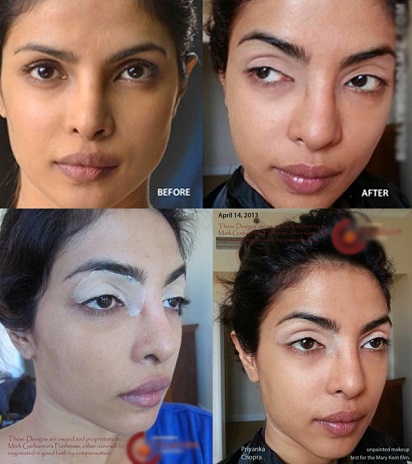
Adarsh (Scoop Whoop) and Bollywood Life tell (and show) us (see pictures) how the Punjabi Priyanka Chopra was transformed into i) an athlete, and ii) a mongoloid north-easterner
More details in Mary Kom, the film.
Why was the mayang Chopra chosen over Manipuri/ NE actresses?
Many ‘mayang’ (non-Manipuri) Indian journalists who love North East India protested that the role of Mary Kom should have gone to a north eastern actress, not Priyanka Chopra.
NE-loving mayang journalists called the decision to cast Priyanka Chopra ‘cultural chauvinism.’ They interviewed Lin Laishram, Bala Hijam et al, who seemed to agree.
Laishram went to the extent of saying, “Ideally, a Manipuri actor or someone from the Northeast should have been cast. But this is neither the fault of the production house nor the director. It is India. It is simply not prepared to accept someone like us on the big screen – so very racially different from them.’’. [Indian Express
More details in Mary Kom, the film.
Her strategy
Unlike her male counterparts, Mary relies on technique and accuracy than raw power. "My left hook is very strong," she says. "Since 2001 I'm using my left hook to make it this far, to be a world champion."
On her ring strategy, Merykom says "I simply try to cramp my opponents so that they don't get any chance to free their arms. 'My height (around five feet) is a problem but my fitness is my advantage. I make my opponents run a lot in the ring, which tires them.' In 2005 she told a felicitation program organized by Indian Amateur Boxing Federation and YMCA: "I do not only rely on my technique or strength but also on my mind," adding that in her 46-kg weight category "I mostly meet different boxers in my weight category as the older ones change to higher weight category. But I have established myself here."
Merykom works out five to six hours a day to stay fit. Coming from a poor family who struggled to educate her siblings, her success as a world champion is a testament to her determination, perseverance and drive to succeed. She has used her earnings from boxing to obtain a new house and land for her parents and savings deposits for her younger siblings but she bemoans the lack of sponsorship for Indian female boxers, saying "I guess that’s because I don’t play tennis or cricket. Seriously, are there no other sports in India?" She has said that she would eventually like to share her boxing experiences while grooming new sports talent in Manipur.
The most successful Indian boxer in history
By winning the bronze medal, in the 51kg category M.C. Mary Kom became India's most successful boxer, male or female, in South Asian history
Government support
“I’ve got a job with the state police, though I don’t have to go to work.”—MC Mary Kom.
Kom receives a salary from the Manipur government as a police officer, but she spends much of her time, with her husband, running the M.C. Mary Kom Boxing Academy, through which she is determined to give nearly 40 disadvantaged Manipuri youth a fighting chance. Already, some of her pupils have won national titles.
She has, since 2007, been teaching boxing to underprivileged youth for free.
In 2013 the Indian national Ministry of Youth Affairs and Sports sanctioned a grant of about Rs. three crore (Rs 30 million) towards the construction of a Gymnasium Hall and the procurement of related equipment, for the Mary Kom Regional Boxing Foundation, being set up in Imphal. The Manipur government allotted the land needed for the project.
Biopic
Sanjay Leela Bhansali, producer and director of mega-budget Hindi-Urdu films started work in 2013 on a biopic on the life of Mary Kom. Miss India 2000, Miss World 2000 and A-list actress Priyanka Chopra is playing the nation’s favourite athlete and favourite sportsperson outside cricket.
Mary accepted an invitation to Mumbai’s Film City and agreed to have a film made on her life.
Favourite foods
See Manipur: cuisine
Major awards
2004 Arjuna Award/ for outstanding national sports achievem
2005 – Gold medal/ Women’s World Amateur Boxing Champion
2006 – Gold medal/ World Women’s Boxing Championship, India
2006 Padma Shri Award/ for distinguished citizenship, India's fourth highest civilian honour.
2008 – Gold medal/ AIBA Women’s World Boxing Championships
2008 MTV Youth Icon
2009 – India’s highest sports honour/ Rajiv Gandhi Khel Ratna
2010 – Gold medal/ AIBA Women’s World Boxing Championships
2011 – Gold Medal/ National Boxing Championships (51kg)
2012 – Bronze Medal/ Summer Olympic Games
2013- The by then 30-year-old Mary Kom was honoured with Padma Bhushan, India's third highest civilian honour.
See also
Mary Kom
Cinemas of the North-East
Assamese cinema: This page has, at the bottom, links to several other articles in Indpaedia.com related to Assamese cinema.
